Understanding NAP in SEO and How to Get It Right
Digital marketing is packed with different acronyms, such as SEO, ROI, SERP, SERM and many others. But few are as confusing as NAP. Now, before you get excited, let us be clear that we’re not referring to the kind of nap we all wish we could take in the middle of the day. NAP in SEO refers to your business’s name and contact details.
In this blog post, we’ll dive deeper into what NAP is, why it matters in local SEO, and how to get it right.
What is NAP?
The acronym NAP stands for Name, Address, and Phone Number, and refers to the information that’s displayed about your business on any website that lists it.
If you want your business to rank high organically when someone runs a local search on Google or other search engines, paying attention to NAP consistency is key.
What is NAP consistency?
Your NAP data is consistent when your business name, address, and phone number are identically and accurately listed across all online platforms, including on your website, social media accounts, business listings and other third-party websites.
Pro tip: Although NAP doesn’t officially include your website’s URL, you absolutely must make sure it’s also listed accurately and identically wherever it appears.
In the world of search engines, details are everything. Consistent NAP data goes beyond verifying the basic facts about your business.
Let’s clear up a common misconception before proceeding: every directory has its own unique way of formatting contact data. Directories may abbreviate “street” to “st.,” display phone numbers with or without a “+1,” or format them differently. As a business owner, you have no control over this.
So, what does consistency really mean in this context? It means that, regardless of formatting, the core information about your business should remain the same across platforms. For example, if your Google Business Profile displays your address as “5 Main St.” and says you’re open on Sundays, Yelp shouldn’t contradict this with an address like “25 Main St.” or hours indicating that you’re open Monday through Friday.
Inconsistencies in your NAP data can confuse search engines, leading them to call into question your business’s identity and location. If search engines find discrepancies, they may lose trust in your listing’s accuracy, which can lead them to favor other, more consistent listings in local search results. This could potentially harm your local SEO rankings.
Let’s compare several examples of correct versus close-but-no-cigar NAP listings to illustrate this point:
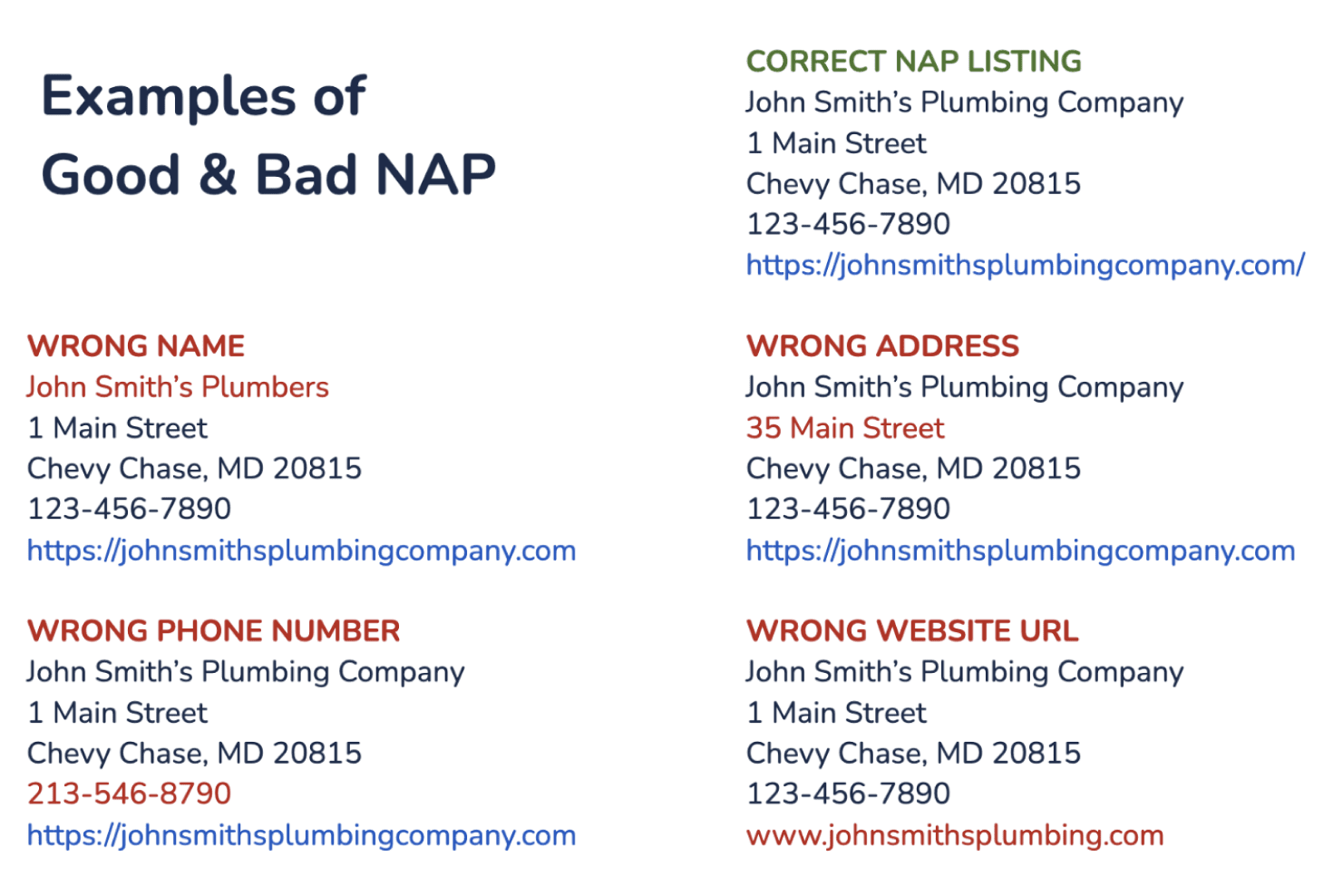
Imagine that all of these NAP variations are circulating on the web. Which one is correct? If people have a hard time understanding which one is the right one, think about what search engines will think.
Whenever the correct NAP data about your business is displayed on a third-party website like a business listings directory or a social media page, search engines notice this and slightly increase your credibility, boosting your chances of getting organically ranked for queries that are related to your company. Even Google itself says that NAP is important for local SEO.
The key point is that consistent NAP citations contribute to your website getting to page one of the local SERPs, getting more organic local traffic, more sales, and, consequently, growing your business in key service areas.

Inconsistent NAP data not only affects search engine rankings, but also leads to user frustration. When users are searching for a particular business or service, they expect to find accurate and consistent information. Inconsistencies in NAP data can create confusion, causing potential customers to lose trust in a business, or worse, turn to a competitor with more reliable information.
As was mentioned, when users encounter different variations of a business’s name, address, or phone number, they may question its legitimacy, become hesitant to engage with it, or even struggle to physically locate it. This frustration can lead to negative customer experiences before they even have the chance to interact with the business directly.
Keep in mind that Google does not use social signals, such as likes, shares, and comments to determine search rankings. But these signals can affect your overall reputation. It’s also true that negative reviews on your Google Business Profile can impact your Google Local Pack and Map rankings, especially if there’s a considerable amount of them.
Now, in order to minimize user frustration and maximize their engagement, businesses must prioritize NAP consistency across all online platforms. By ensuring that NAP data is accurate, uniform, and up-to-date, businesses can build credibility and trust among potential customers. This not only helps improve local search rankings but also fosters positive customer experiences, leading to increased brand loyalty and organic growth within key service areas.
Consistent NAP data benefits both businesses and their customers by providing a seamless and reliable online experience that aligns with the expectations of today’s users.
Example of consistent NAP
To give you a better understanding of what you’re aiming to achieve as a result of having consistent NAP data, let’s take a look at a Boston-based cleaning services company called Cleanzen.
If we simply enter the name of the company into Google Search, we will see data on the business pulled from Google Business Profile on the right hand side.
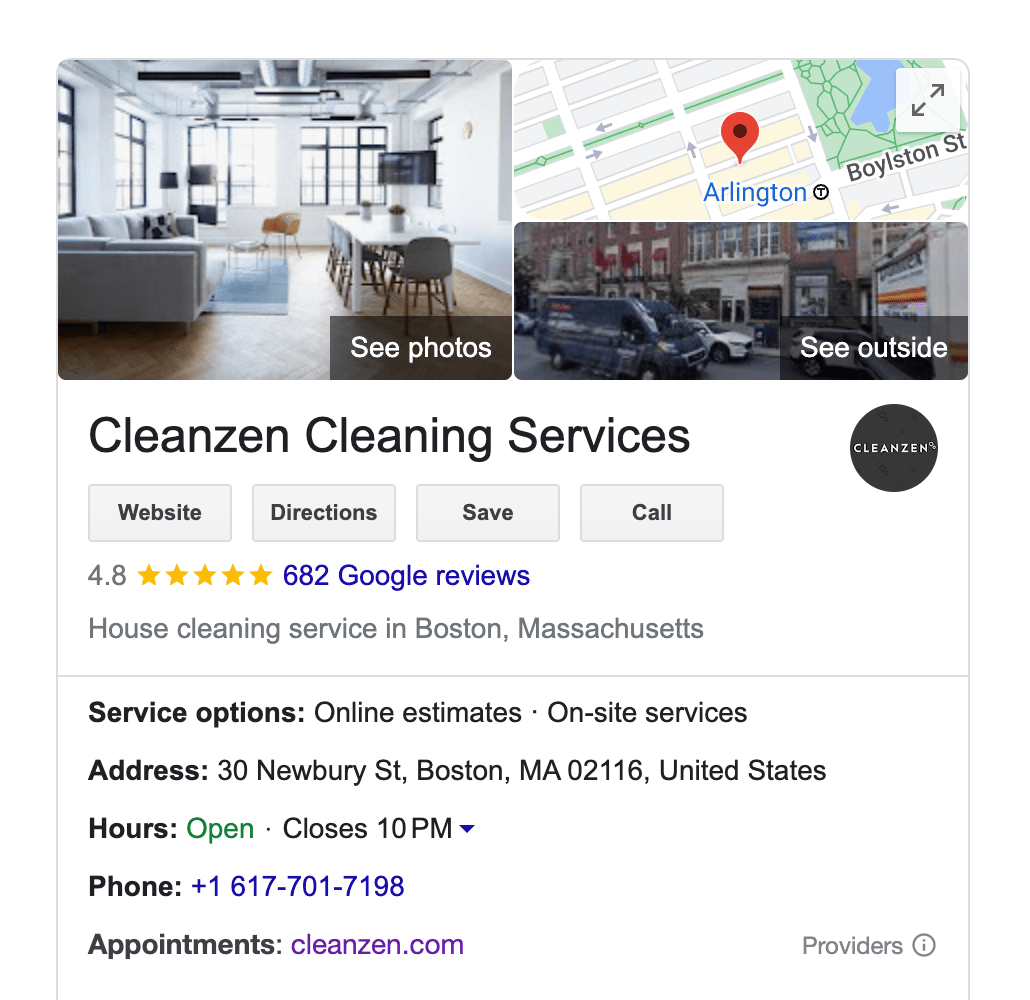
To make sure they’re providing consistent information regarding their business’s name, address, and phone number, let’s check in on their website to see if the same data is presented there:
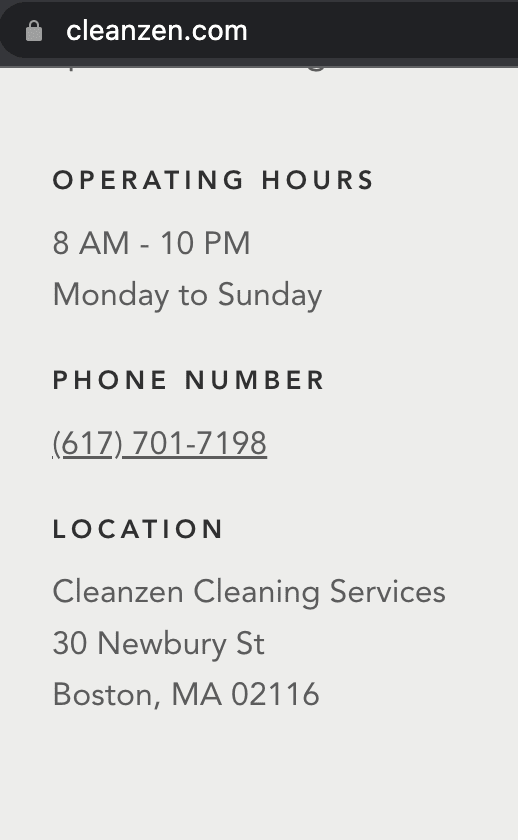
Getting the NAP data right in just these two places is the bare minimum. The trick to having consistent NAP data is to provide the same information across all business listings and directories that your business has been added to.
So, how does Cleanzen fare in this regard?
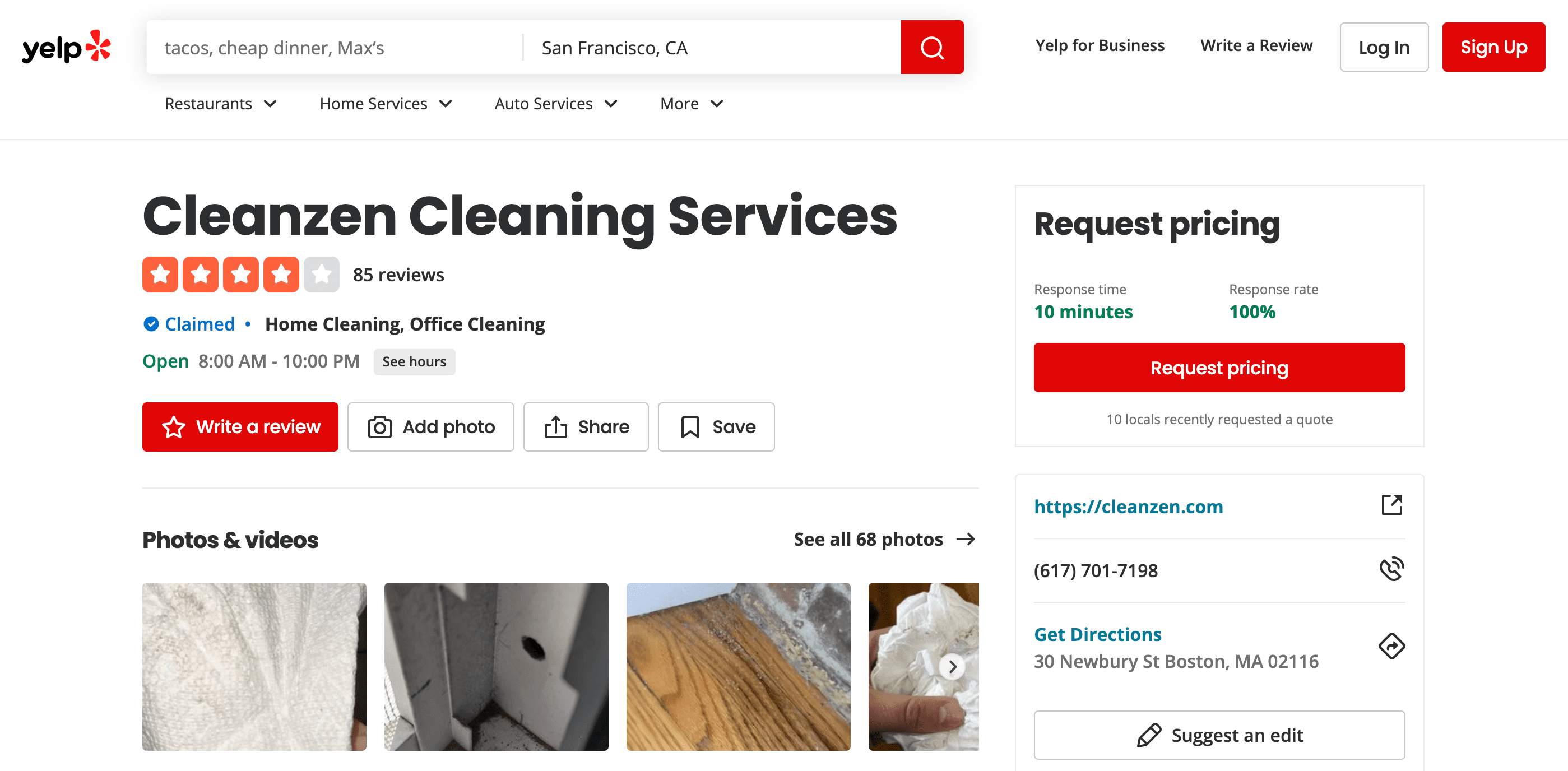
Cleanzen is very consistent. The name, address, and phone number are always the same regardless of which platform the data is on. This is exactly what you should strive for.
Why NAP and its consistency is important for SEO
NAP consistency plays a vital role in local SEO, as it directly impacts a business’s visibility in local search results and Google’s Local Pack. Google’s local search algorithm considers various factors, including the accuracy and consistency of a business’s NAP data across online platforms. By building citations with a consistent NAP on your Google Business Profile listing, along with other online directories and websites, you can positively influence your local rankings and increase your chances of appearing in Google’s Local Pack.
One key reason why NAP consistency is crucial for SEO is its impact on user experience. According to Search Engine Journal, user experience is a significant factor in local SEO because it can affect the overall performance of a business in search engine rankings.
Consistent NAP data makes users more likely to trust a business and engage with it, resulting in a better user experience. This can lead to more positive online reviews, improved customer loyalty, and increased local search rankings.
It’s also true that NAP consistency helps search engines understand the legitimacy and relevancy of a business. Inaccurate or inconsistent NAP data can confuse search engines, making it difficult for them to associate a business with its physical location and services. So when displaying search results, search engines will instead consider other businesses who have more reliable information. This negatively impacts the affected business’s rankings.
On top of that, consistent NAP data in citations helps build a strong online presence. Citations are mentions of a business’s NAP information on other websites, and they are considered a significant ranking factor in local SEO. When a business has consistent citations, search engines will perceive it as more credible and trustworthy, which can lead to higher rankings in local search results.
Lastly, NAP consistency ensures that search engines can accurately index and categorize a business by its geographic location, increasing the business’s chances of appearing for relevant local search queries. By maintaining a consistent NAP, businesses can improve their online visibility and attract more potential customers who are actively searching for their products or services.
For example, if you run a coffee shop in Boston, using a consistent NAP across various online platforms aids search engines in accurately recognizing that your business is in Boston. This means that when a user in or near Boston searches for “coffee shops near me,” your business will have a higher chance of appearing in search results.
All of this highlights the fact that NAP consistency is crucial for SEO. It influences a business’s local search rankings, user experience, and overall online credibility. By ensuring that your NAP data is accurate and consistent across all online platforms, you can optimize your local SEO efforts and enhance your business’s online presence.
Let’s look at some ways to accomplish that.
Audit your NAP
Before delving into the specifics of auditing your NAP data, let’s first understand why NAP inconsistencies can occur:
- You’ve moved your business to a new address but failed to update all existing citations and directory listings.
- Your store address and company’s registered address are different and both of them are used online.
- You’ve generated various phone numbers for attribution tracking, creating discrepancies in contact information.
- You haven’t consistently updated your business hours, particularly during holiday seasons, across all platforms.
For these reasons alone, auditing your website’s NAP data on a regular basis is essential.
Conducting a manual audit of your Name, Address, and Phone number involves painstakingly going through each page of your website to verify the accuracy and consistency of the information displayed about your business. This process requires a keen eye for detail and a great deal of patience, as even the smallest inconsistency can impact your SEO and, consequently, your online visibility.
Also, the process of auditing your NAP isn’t confined to your website and Google Business Profile. It also extends to searching your business’s name on the internet and examining various directories, social media platforms, and review sites to ensure they’re presenting accurate information about your business. Not only is this a time-consuming task, but it’s also easy to overlook vital details or platforms that could be affecting your local SEO.
You’re better off using an automated tool like SE Ranking’s Local Marketing tool, which can make this process more efficient and lead to more accurate results.
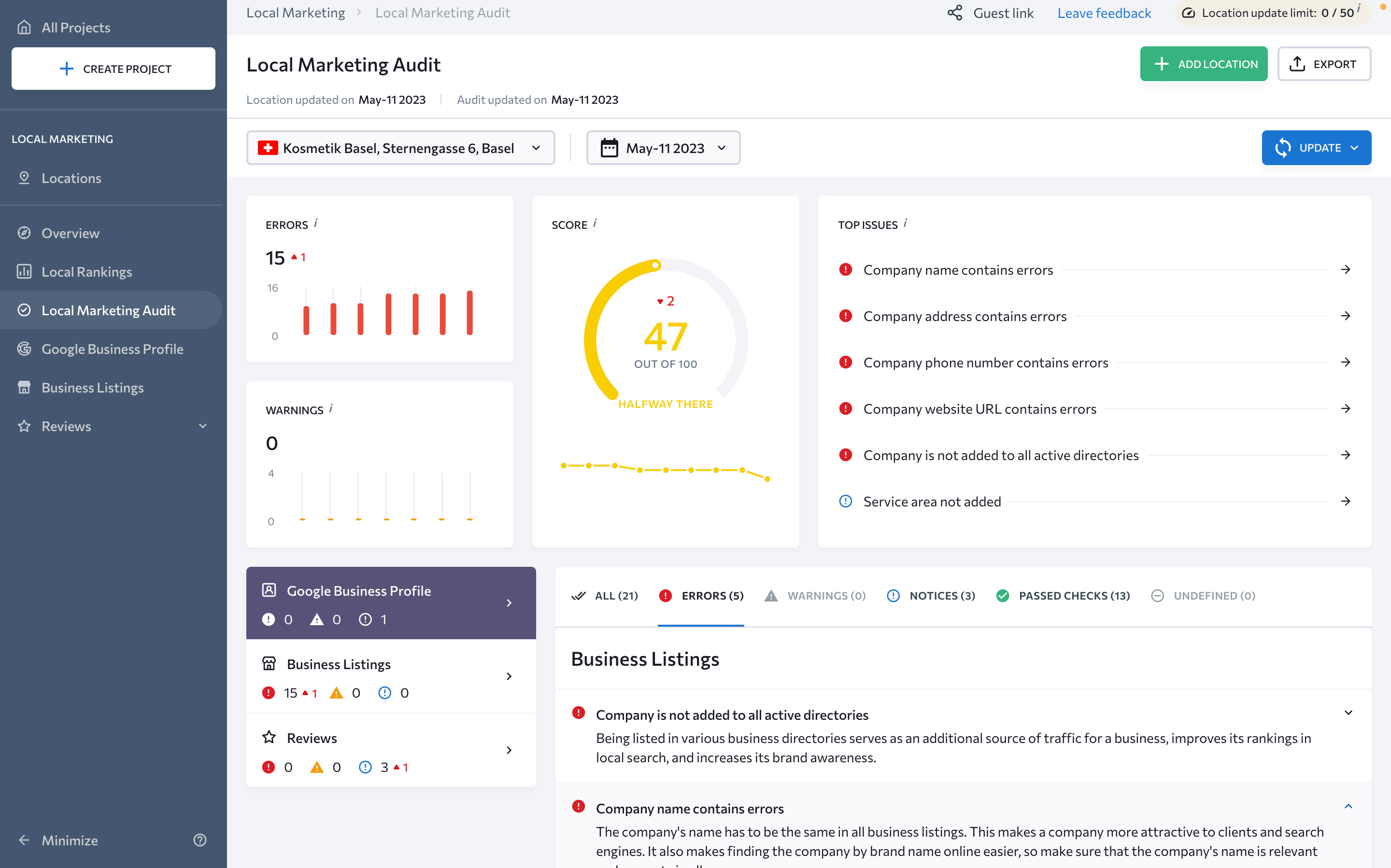
This tool quickly scans your website and the internet to find any inconsistencies or errors in your NAP details that could be affecting your search engine rankings. This local SEO tool not only saves you time but also provides you with a clear overview of your online presence, making your local SEO efforts more effective.
Additionally, SE Ranking’s Local Marketing tool can assist you in the following: monitoring your rankings on Google Maps, optimizing your Google Business Profile listing, and highlighting global and local business listings and directories where your business has not been included yet. It also enables you to stay on top of online discussions about your business and draw AI-based insights from customer reviews.
Get your website in order
Since your website is your main face to the online world, including both people and search engines, you definitely have to get your details right.
Start by cross-referencing the data in your paperwork with the details on your website. This includes verifying that your NAP info is correct as well as consistent, with proper formatting, spelling and all.
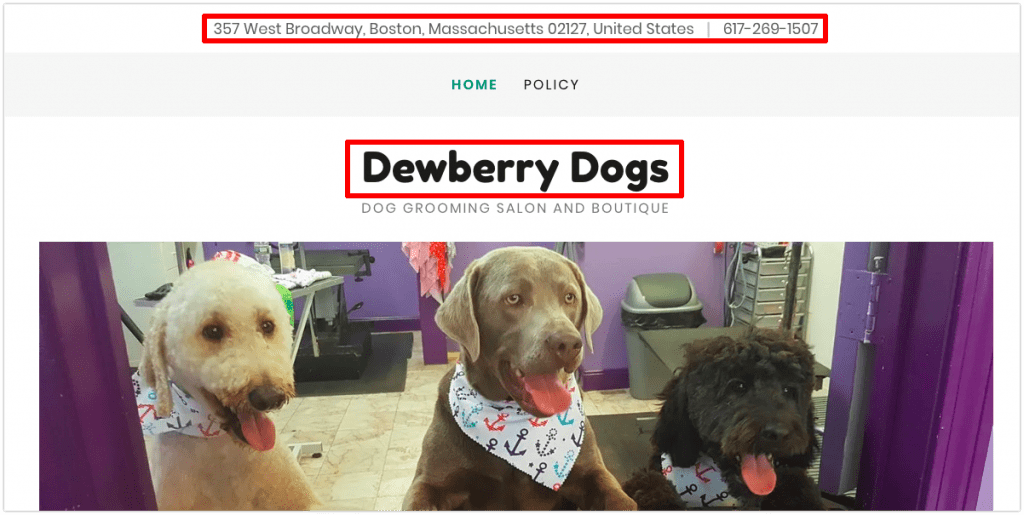
For local businesses, it’s recommended to show the company’s name, address, and phone number in both the website’s header and footer, as is shown in the examples above and below.
Just make sure your header and footer match so that your NAP data appears on all of your site’s pages.
After all, search engines don’t index websites, they index pages.
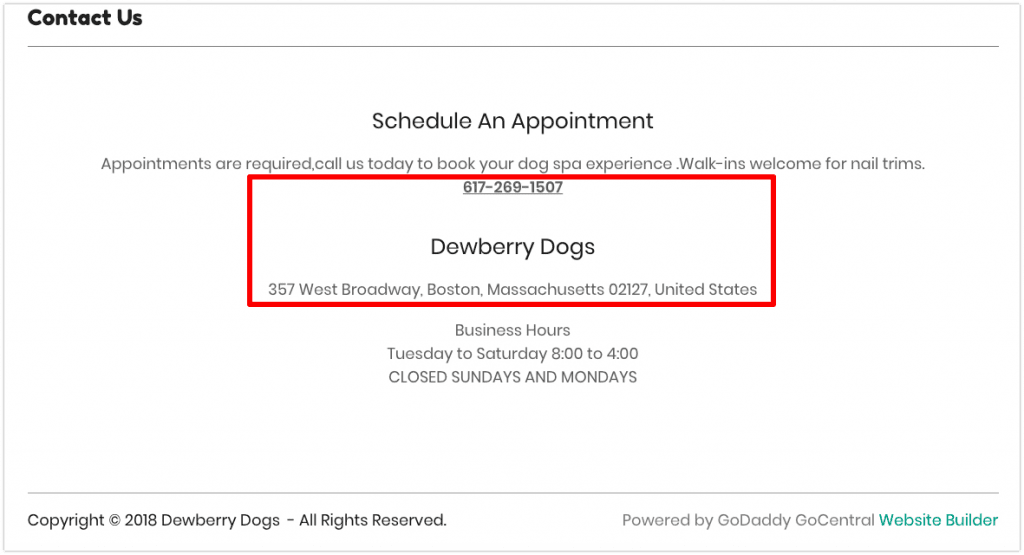
It’s crucial to prominently display your NAP information on your website. It ensures that both users and search engines can easily access it. You should ideally include your NAP details on your Contact page and About Us section, as these are the main areas users look for contact information. Plus, incorporating your NAP data in the footer of your website ensures that it is consistently visible across all pages, enhancing accessibility.
Some businesses also choose to include their NAP information in the header of their website. While not mandatory, this can enhance visibility and user experience. Placing your contact information at the top of each page makes it easily accessible for users, especially if your location receives visitors or serves as a pickup point. However, if you opt to add your NAP data to the header, ensure that it is consistent with the information displayed in the footer and on your Contact and About Us pages.
Strategically placing your NAP information on your website creates a seamless user experience and increases the chance that search engines will correctly index your business. Consistency and accessibility are key when it comes to displaying your NAP data, so be sure to keep these factors in mind as you optimize your website for local SEO.
Schema markup
Schema markup plays a vital role in local SEO and maintaining NAP consistency by helping search engines better understand and index your business information.
Let’s take a look at some key points to consider regarding schema markup in relation to NAP:
- Structured Data. Schema markup is a type of structured data that enables search engines to better understand and interpret the content on your website. Implementing schema markup for your local business becomes an additional method to convey precise and accurate information about your NAP (Name, Address, Phone number) data. This makes your site more accessible to search engines, enabling them to index your business information accurately and prominently display it in local search results.
- Local Business Schema. Google recommends using the LocalBusiness schema type to represent your business and its NAP information. It includes properties like name, address, telephone, and URL, which you can use to accurately describe your business’s contact details.
- JSON-LD Format. While all formats are equally fine, Google recommends using the JSON-LD for structured data. This format is easier for website owners to implement and maintain compared to other formats like Microdata or RDFa. The bottom line is that you shouldn’t have any issues with structured data as long as the markup is valid and properly implemented.
- Required and Recommended Properties. While some properties in the LocalBusiness schema are required (e.g., name, address, telephone), others are recommended or optional. Including as many relevant properties as possible can enhance the search engine’s understanding of your business and improve your local search visibility.
- Test and Validate. Before implementing schema markup on your website, use Google’s Structured Data Testing Tool or the Rich Results Test to validate your markup and identify any potential errors. This ensures that your NAP data is accurately formatted and easily understood by search engines.
Implementing the points above can make it easier for search engines to understand your business information, leading to increased visibility in local search results.
For more info on using local business structured data, click here.
Get into the Google Business Profile game
Google is undoubtedly the most popular and powerful search engine today. This means that tons of people are using it to look for products and services, including those offered by your business.
Now, since we’re focusing on the question of how to get search engines to trust your NAP data, it’s only logical to ensure the accuracy of your information in a place where Google will seek it out: your Google Business Profile page.
In your verified GBP account, make sure that the name of your business, as well as the address and phone number, is listed exactly as it appears in your official registration documentation and on your website.
Next, you know the drill: if the NAP data doesn’t match, update it.
After Google verifies your business, you will see its correct NAP data in Google’s Local Pack when you or anyone else looks for your company. With some additional SEO magic, you can get your business to show up when people look for your service in your local area.
Update business directories and listings
It’s worth listing your business on all reputable local, national, and/or industry-specific directories to get more traffic and citations.
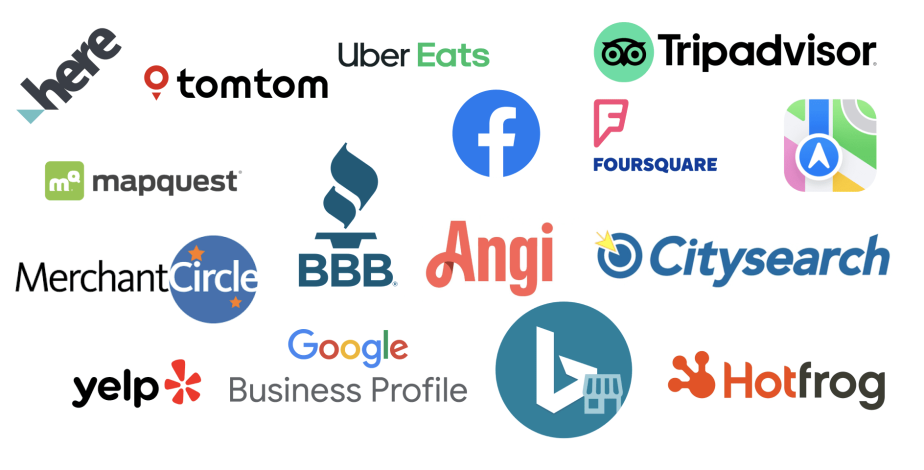
There are three types of directories where you can get NAP citations:
- Local. These directories are linked to the city or region where you conduct business in and only list relevant local businesses. By getting listed in these directories, you reinforce to search engines that you do exist and provide clear local information.
- National. National-level directories are great for getting more citations due to their high traffic. However, the audience they attract may not be as targeted as local directories, making them slightly less valuable. That being said, individuals from the ‘right’ locations are just as likely to utilize national directories as they are local ones.
- Industry. Generally, these directories provide regional, niche-specific listings. Although they may be difficult to come across depending on your business’s niche, once you do find one, it’s worthwhile to get listed in them. This way, your business will appear in search results for service queries, such as plumbing, repairs, grooming, etc.
Keep in mind that when checking your business’s listing in these directories, pay close attention to your full name, address, phone number, and URL address.
As a matter of fact, if you have a project in SE Ranking, you can take advantage of our Local Marketing tool to do this.
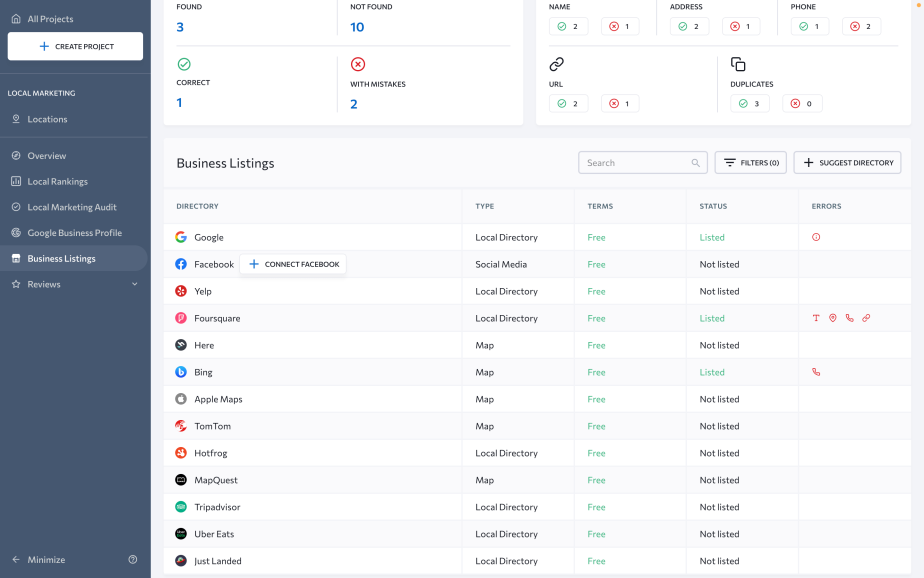
With this tool, you can find a suggested list of trusted directories and catalogs where your business can potentially get listed, increasing your search visibility and boosting your business performance. These business listings include Google, Facebook, Yelp, Foursquare, Here, Bing, Apple Maps, TomTom, Hotfrog, MapQuest, Tripadvisor, Uber Eats, and Just Landed.
We are constantly expanding our list and encourage you to help us by taking advantage of the Suggest directory option.
While updating your info in various online directories, it’s also useful to check up on other details in your profile, such as the logo, working hours, number of employees/customers, social media profiles, etc.
Just make sure that the information you find or provide on these listings is consistent with what is stated in your official paperwork, website, and on Google Business Profile. If discrepancies exist, update them.
Keep an eye on social media
When completing your business profile in online directories and listings, you will most likely be asked to provide your company’s social media profiles. Now, since many social networks have evolved into platforms for information distribution, you want to ensure consistency by providing them with the same NAP.
It’s common for companies in some industries to have profiles on multiple social platforms in an effort to reach a wider audience. This is why it wouldn’t be unusual to have inconsistent NAP data, which can unfortunately be seen by potential customers and search engines.
With that in mind, take the time to review all your company’s active profiles on popular social media platforms like Facebook, Twitter, Instagram, Pinterest, YouTube, and LinkedIn. You want to ensure that your NAP data across all these platforms perfectly aligns with the information on your website. Remember, consistency is key.
This, along with all the other steps in the post, will set you on the right path to getting featured on page one of local searches.
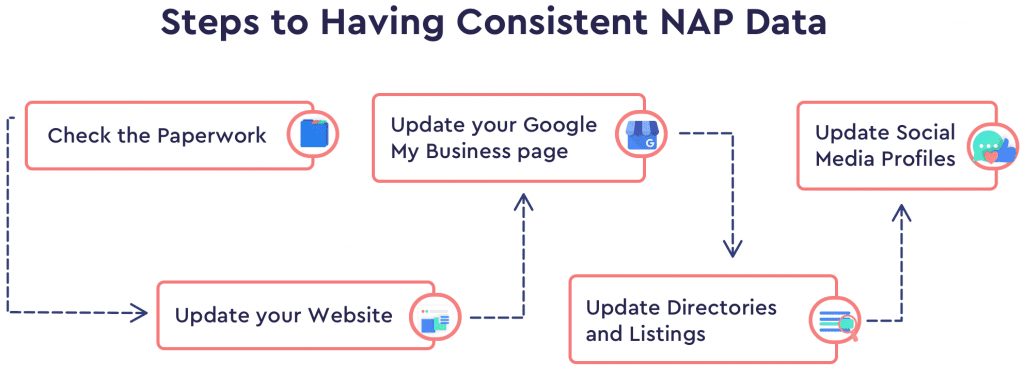
NAP consistency for multiple locations
If your business has multiple locations, it’s crucial to maintain consistent NAP information for each location across all online platforms.
For instance, if you have a pizza parlor with branches in New York and Los Angeles, you should maintain separate and consistent NAP information for each location. That way, when someone searches for a pizza parlor in New York, your New York branch shows up. The same would apply to Los Angeles.
Business location vs. target market
Depending on the nature of your business and your specific goals, you may want to target keywords on your website and local listings based on either your business location or your target market. Let’s take a closer look at the options:
Local businesses: If you run a local business where customers need to visit your physical location (like a restaurant or a retail store), then you should target keywords based on your business location. This will help in attracting customers who are nearby and are likely to visit.
Online businesses: If you operate an online business that can serve customers regardless of their location, you should focus your marketing efforts on your target market. For instance, if you’re based in Boston but sell handmade crafts online to customers across the U.S., then your SEO strategy should be focused on the U.S. market as a whole, rather than just Boston.
Location-specific services: If your services are specific to certain locations outside your business’s physical location, then your keywords should focus on those target markets. For example, if you’re a digital marketing agency based in Chicago but serve clients in New York and Los Angeles, you should target keywords in New York and Los Angeles.
It’s critical to note that when setting up your GBP listing, you must provide your real physical address, regardless of your service area. This step is crucial for the verification and approval process. Be aware that Google can suspend listings that use incorrect addresses, even if you service clients in those locations. Should your actual address and service areas differ, you can hide your physical address and specify your service area at a later stage.
But remember, it’s important to use location-based keywords judiciously. While these keywords are effective in attracting local customers, excessive use can lead to penalties from search engines. Most importantly, always strive to create high-quality content that genuinely meets the needs of your target audience. This is what search engines truly value.
Over to you
In the realm of local SEO, whenever you encounter the acronym NAP, you’ll now understand its meaning (unfortunately, it doesn’t stand for a short nap).
You should also know how to ensure consistent business data across the web.
One final piece of advice to consider is that you should create a list of all the places your business is listed in. This will allow you to update your business’s information quickly and easily whenever you make any changes to its name, address, phone number, or URL address.
The bottom line? NAP can significantly impact your business’s local rankings, as it provides vital information to both potential clients and search engines. So don’t rush! Take your time to get your NAP data right!
